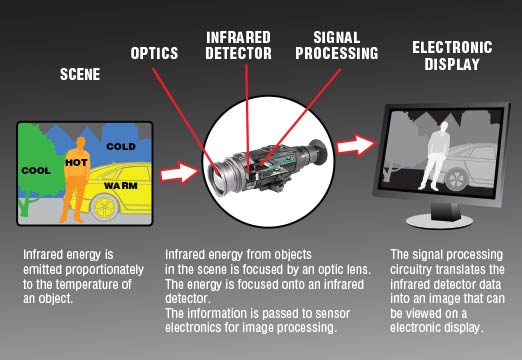INFRARED LIGHT CAN BE SPLIT INTO THREE CATEGORIES:
- Near-infrared (near-IR) - Closest to visible light, near-IR has wavelengths that range from 0.7 to 1.3 microns, or 700 billionths to 1,300 billionths of a meter.
- Mid-infrared (mid-IR) - Mid-IR has wavelengths ranging from 1.3 to 3 microns. Both near-IR and mid-IR are used by a variety of electronic devices, including remote controls.
- Thermal-infrared (thermal-IR) - Occupying the largest part of the infrared spectrum, thermal-IR has wavelengths ranging from 3 microns to over 30 microns.
A SPECIAL LENS OF THERMAL SCOPE FOCUSES THE INFRARED LIGHT EMITTED BY ALL OF THE OBJECTS IN VIEW
The focused light is scanned by a phased array of infrared-detector elements. The detector elements create a very detailed temperature pattern called a thermogram. It only takes about one-thirtieth of a second for the detector array to obtain the temperature information to make the thermogram. This information is obtained from several thousand points in the field of view of the detector array.
The thermogram created by the detector elements is translated into electric impulses.
The impulses are sent to a signal-processing unit, a circuit board with a dedicated chip that translates the information from the elements into data for the display.
The signal-processing unit sends the information to the display, where it appears as various colors depending on the intensity of the infrared emission. The combination of all the impulses from all of the elements creates the image.
Unlike traditional most night-vision equipment which uses image-enhancement technology, thermal imaging is great for detecting people or working in near-absolute darkness with little or no ambient lighting (i.e. stars, moonlight, etc, )






